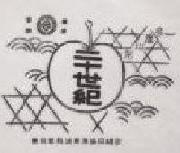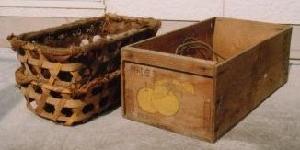History of pear cultivation
Making pears in the Edo period
It is unclear when pear cultivation began in Inagi because there are no old records, but according to legend, Genroku Naganuma Village magistrate Heiemon Masuoka and Kawashima Sajiemon but, Yamashiro Province (Southeastern Kyoto Prefecture) on official business, and on the way back Light snow It is said that he was the first to bring home a pear seedling called "Kyoto Pear Tree." The original tree was in the front garden of the Kawashima family home in Higashinagumanuma until 1889. Trunk circumference Riga is 6 shaku (about 180 cm), Branching It is said that it was a large tree measuring 30 tsubo (approximately 100 square meters). After that, pear cultivation gradually spread, and by the end of the Edo period, it is recorded that there were over a dozen pear farms in the areas around Naganuma and Yanokuchi villages.

pear wrapping paper

Pear shipping box and pear basket
Pear production since the Meiji period
Pear cultivation began in earnest after the Meiji period, and pear-growing associations were established in various regions. In Higashinagumanuma Village, 13 farmers established the " Alliance " was established, and in 1904 "Higashinaganuma Lishan In Yanokuchi Village, the Yanokuchi Pear Mountain Social Gathering Association was established in 1902. The association purchased and shipped pear seedlings and fertilizers jointly. In the latter half of the Meiji period, pear cultivation rapidly increased, which was due to the introduction of a new variety, the " Chojuro " was introduced.
Kawasaki Daishigawara Made with a strong sweet taste Chojuro It became the mainstream of pear cultivation in Inagi and was widely cultivated. In addition, around 1905, a new variety " 20th century " was also introduced, and as the cultivation area of Inagi pears increased, so did the sales channels. In the latter half of the Meiji period, sales channels spread from Hachioji in the west to Ome, Tokyo city in the east, Tokorozawa in the north, and Yokohama in the south. The conversion of rice paddies into pear orchards, which began in the mid-Meiji period, continued into the Taisho period. In 1919, the Inagi Fruit Production Association was formed, and efforts were made to improve techniques and expand sales channels. In 1927, pear production associations along the Tama River united to form the Tama River Fruit Production Association, and in 1932, the " Tamagawa Pear This period can be called the golden age of pear production. Tourist Pear Orchard However, pear cultivation, which reached a peak in the 1950s, has been on a gradual decline since the 1960s.
Types of pears grown in Inagi
| kinds |
harvest time |
| longevity |
Early August to mid-August |
| Tama |
Early August to late August |
| Kosui |
Late August to early September |
| New century |
Late August to early September |
| Asahi |
Late August to early September |
| Inagi |
Late August to early September |
| Kiyotama |
Late August to late September |
| Chojuro |
Early September to late September |
| twentieth century |
Early September to late September |
| Kikusui |
Early September to late September |
| Excellence |
Early September to mid-September |
| rich water |
Mid-September to late September |
| Niitaka |
late September to early October |
| new peace |
Early October to mid-October |
| Yoshino |
Early October to late October |
| Nova |
Early October to late October |
| new snow |
Late October to early November |
| Shuho |
Late October to early November |
| emerging |
Late October to early November |
| Atago |
Late October to early November |
The four pear varieties, Inagi, Kiyotama, Shintaihei, and Yoshino, were born in Inagi.









